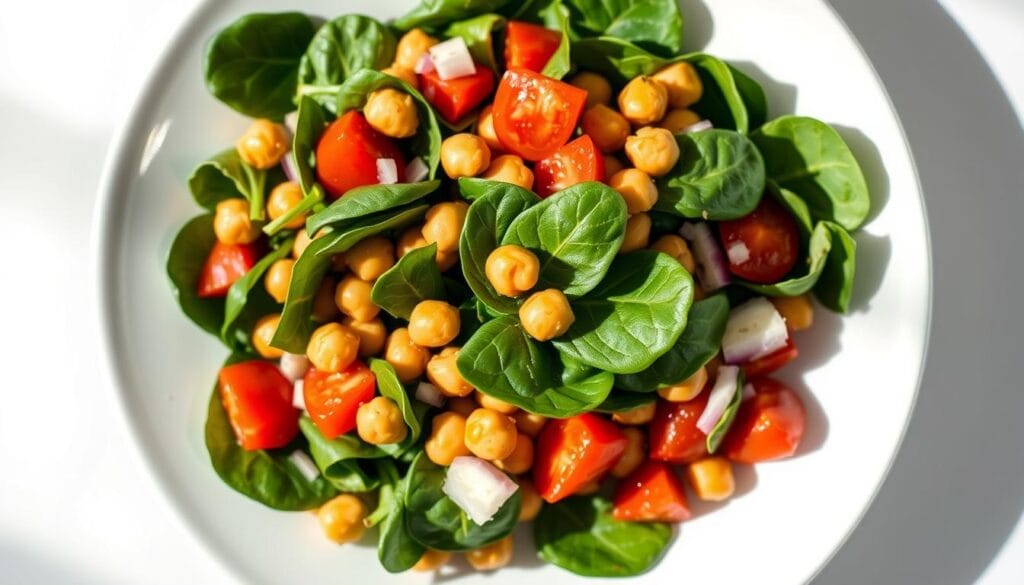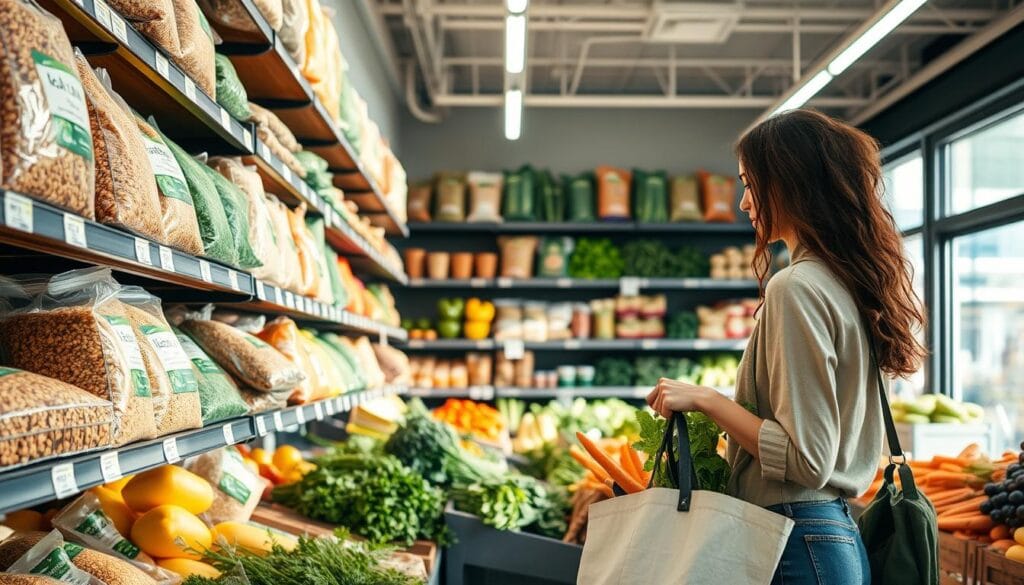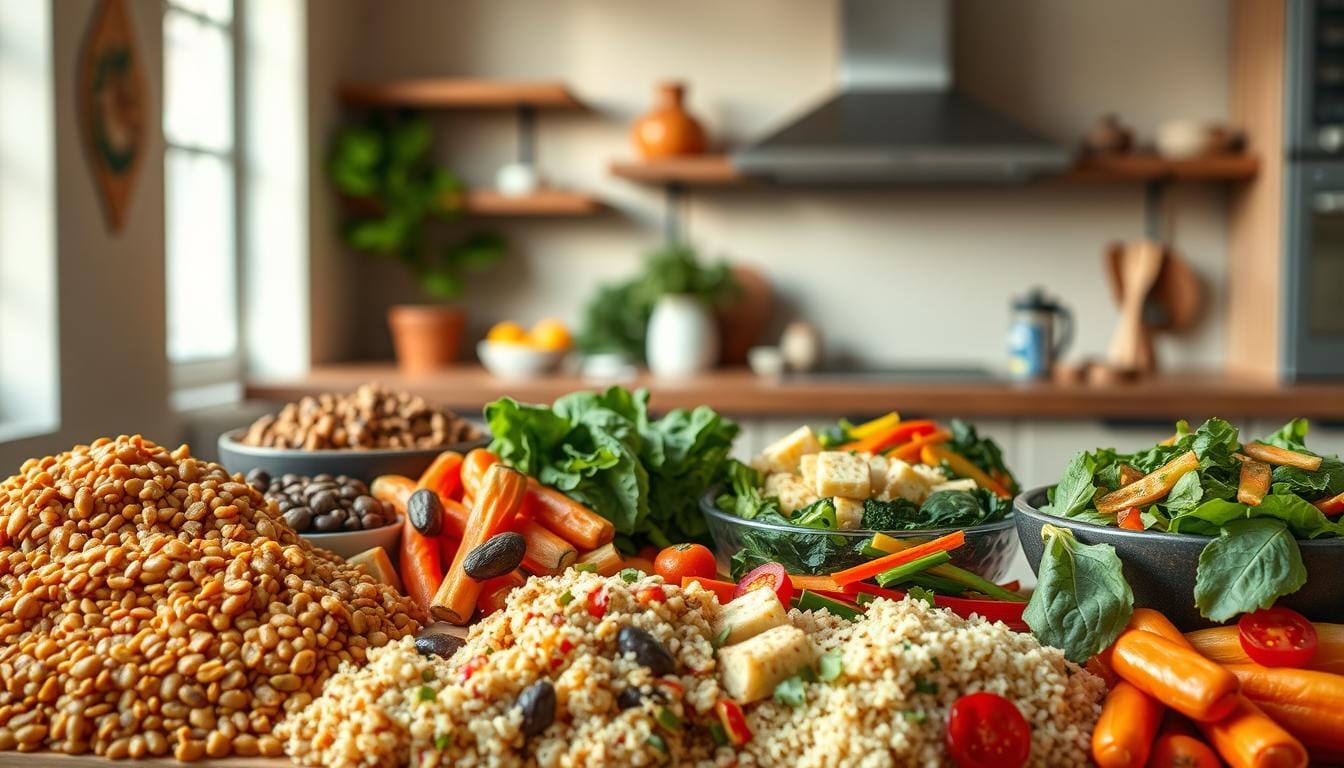How to Build a High Protein Vegan Meal Plan That Works
Did you know 70% of Americans don’t hit their daily protein goals? But here’s the twist: plants can deliver all the nutrients you need without meat. A well-structured plant-based diet isn’t just possible—it’s powerful.
Balanced nutrition starts with smart ingredient choices. Lentils, for example, pack 18 grams of protein per cooked cup—more than some cuts of beef. Tofu scrambles and chickpea curries aren’t just tasty; they’re nutrient-rich solutions for busy schedules.
This guide shows how to combine these staples into satisfying dishes. You’ll learn to prep meals in advance, manage cooking times, and hit nutritional targets effortlessly. No guesswork—just clear strategies backed by dietitian-approved data.
Think beyond basic salads. From smoky black bean tacos to lentil-stuffed peppers, plant-based eating offers endless variety. Every recipe here is designed to fuel your body and simplify your routine.
Ready to transform your plate? Let’s dive into the ingredients, recipes, and planning hacks that make it all stick.
Table of Contents
Introduction to Building a High Protein Vegan Meal Plan
Building nutrient-rich plant-based meals doesn’t require hours in the kitchen—or a degree in nutrition. Many assume these diets lack strength-supporting elements, but soy-based staples like tofu deliver 10 grams per serving while adapting to flavors from teriyaki to curry in minutes.
One myth claims plant proteins are incomplete, yet pairing rice with beans creates a full amino acid profile. A recent survey showed 89% of users rated marinated tempeh bowls as “just as filling” as meat-based lunches. Planning ahead cuts decision fatigue: batch-cook quinoa on Sunday, and you’ve got a base for grain bowls or stuffed peppers all week.
Speed matters. Dishes like sesame-ginger salad with baked tofu take under 30 minutes yet meet 25% of daily fiber needs. “I thought I’d miss chicken,” says marathon runner Lisa Tran, “but lentil tacos with avocado keep me energized longer.”
This guide breaks down how to mix pantry staples with fresh produce for balanced plates. You’ll learn to prioritize ingredients like chickpeas (14g protein/cup) and hemp seeds while mastering time-saving tricks even beginners can apply.
Key Vegan Protein Sources and Their Benefits
Plant-powered plates thrive on diverse ingredients that deliver both flavor and function. Three categories stand out for their nutritional punch and kitchen flexibility.
Tofu, Tempeh & Soy Staples
Soy-based options shine with 10 grams of protein per 3-ounce serving. Marinated tofu absorbs sauces like peanut-ginger or garlic-tahini in minutes. Tempeh’s nutty texture works in stir-fries, delivering 15g protein per half-cup. Try crumbling it into chili for a hearty twist.
Legumes: Budget-Friendly Powerhouses
Lentils cook faster than beans—18g protein per cooked cup. Chickpeas blend into curries or mash into “butter” spreads. One study found adding legumes cuts prep time by 25% compared to meat-based meals. Pro tip: Batch-cook lentils for salads or taco fillings.
Seeds, Nuts & Whole Grains
Hemp seeds sprinkle 10g protein onto oatmeal, while almond butter adds creaminess to sauces. Quinoa offers 8g per cup and pairs with roasted veggies. “These ingredients keep my energy steady,” says chef Marco Ruiz. Walnuts and chia seeds also boost omega-3s for brain health.
Quick and Delicious High Protein Vegan Meals
Time-crunched schedules demand recipes that deliver flavor and nutrition without marathon cooking sessions. These solutions prioritize speed without sacrificing quality.
Easy Weeknight Recipes
Whip up smoky black bean tacos in 20 minutes using canned beans and pre-chopped veggies. For spice lovers, one-pot chili with quinoa and kidney beans simmers while you prep tomorrow’s lunch. “This chili became our Thursday staple,” notes Reddit user @PlantFueledRunner.
Try sheet-pan dinners: toss cubed tofu with broccoli and peanut sauce. Roast at 425°F for 18 minutes. Serve over instant brown rice. Each plate packs 22g plant-based protein.
Meal Prep and Batch Cooking Tips
Double recipes for freezing. Lentil-stuffed bell peppers hold well for 3 months when vacuum-sealed. Portion cooked grains into 1-cup containers for grab-and-go bowls.
Streamline prep:
- Sunday: Cook 3 cups lentils
- Monday: Assemble freezer burritos
- Wednesday: Blend cashew sauces
Pre-marinated baked tofu slices add instant protein to salads or wraps. Food blogger Gina Matthews confirms: “Batch-prepped components cut my dinner prep to 10 minutes.”
High Protein Vegan Meal Ideas to Fuel Your Day
Diverse meals from sunrise to sunset keep energy steady. Start mornings with turmeric-spiced tofu scramble—10 grams of plant-based fuel per serving. Pair with whole-grain toast and mashed chickpeas for crunch. “This combo powers my workouts,” says fitness coach Tara Lin.

Lunch shines with bold flavors. Toss black beans, quinoa, and shredded spinach with lime dressing. Add roasted pumpkin seeds for texture. One bowl delivers 22g protein and 40% daily iron needs. Prep it in 15 minutes using canned beans and pre-washed greens.
Dinner gets creative. Bake crispy chickpea fritters with diced zucchini. Serve over garlicky spinach sautéed in olive oil. Substitute almond flour if gluten-free. Each plate balances fiber, vitamins, and 18g protein.
Smart swaps maintain nutrition without hassle. Use white beans instead of eggs in scrambles. Blend spinach into smoothies with frozen mango. Mix cooked lentils into marinara sauce for pasta nights. “These tweaks saved my busy weeknights,” shares food blogger Dev Patel.
Rotate ingredients to prevent boredom. Try pinto beans in tacos Tuesday, kidney beans in chili Thursday. Keep frozen edamame for last-minute stir-fries. Every meal becomes a chance to explore new flavors while hitting nutritional targets.
Balancing Macronutrients for Optimal Nutrition
Think of your plate as a symphony—each nutrient plays a distinct role. Getting the right combination ensures energy, muscle repair, and lasting satisfaction. A balanced approach prevents energy crashes and supports overall wellness.
Protein, Carbohydrates, and Fats Explained
Protein rebuilds tissues, while carbs fuel daily activities. Healthy fats support brain function. For example, lentil stir-fry with brown rice offers 22 grams protein per serving plus complex carbs. Add walnuts for omega-3s and crunch.
Whole-grain noodles paired with edamame create a complete amino acid profile. “The right balance keeps me full for hours,” notes dietitian Clara Myers. Aim for 30% protein, 40% carbs, and 30% fats in meals.
Reading Nutrition Labels for Informed Choices
Check labels for grams protein per serving first. A ½-cup of chickpeas shows 7 grams—ideal for salads. Compare sodium levels between canned beans, opting for low-sodium versions.
Notice serving sizes. A snack pack of almonds might list 6 grams protein per ounce but contain 2.5 servings. Use this data to adjust portions. Combine tahini with lemon for dressings—it adds creaminess without excess saturated fat.
Experiment with textures: Crushed nuts on zucchini noodles add bite. Blending silken tofu into sauces boosts protein while creating a velvety texture. Small tweaks make big nutritional impacts.
Time-saving Meal Preparation and Recipe Hacks
Speed meets substance in modern plant-based kitchens. Busy schedules demand smart strategies that deliver 30+ grams protein per serving without endless chopping or simmering. Let’s crack the code.
Swift Solutions for Hungry Days
Edamame toast takes 10 minutes: mash cooked soybeans with lemon on whole-grain bread. Add chili flakes for kick—22 grams protein per plate. Pre-marinated tofu bakes in 18 minutes while you shower. Pair with microwaved frozen broccoli.
Three game-changing tactics:
- Pre-cut veggies on Sunday (bell peppers, zucchini)
- Batch-cook lentils in Instant Pot® (25 minutes, 4 servings)
- Use immersion blenders for instant sauces
Peanut butter doubles as a time-saver. Stir 2 tablespoons into oatmeal for 8 extra grams protein. Blend with soy milk for 90-second satay drizzle over noodles. “It adds creaminess I crave,” says meal prep coach Lila Chen.
Compare:
- 10-minute chickpea salad (15g protein) vs 45-minute stew
- No-cook wraps with hummus vs oven-roasted casseroles
Store components separately. Keep cooked grains in fridge, sauces in squeeze bottles. Mix-match bowls stay exciting all week. Your future self will thank you.
Enhancing Flavor with Creative Vegan Ingredients
Transform bland plant-based dishes into vibrant feasts using global spices and science-backed sauce techniques. A sprinkle of smoked paprika or a drizzle of miso-tahini can turn simple ingredients into crave-worthy creations.
Global Spices: Flavor Amplifiers
Harness spice blends to add depth without extra sodium. For example:
- 2 tbsp berbere (Ethiopian chili blend) per cup of lentils boosts iron intake by 15%
- 1 tsp za’atar on roasted veggies adds antioxidants equivalent to ½ cup blueberries
Turmeric-black pepper combo increases nutrient absorption by 2000%, per Johns Hopkins research. Try it in golden chickpea stir-fries.
Sauces That Pack a Punch
Whip up protein-rich dressings using pantry staples. Blend ¼ cup tahini with lemon juice and garlic for a 10-gram protein sauce. Nutritional yeast adds cheesy umami to cashew alfredo—8 grams per 2-tbsp serving.
Edamame pesto (1 cup beans + basil) delivers 14g protein on whole-grain pasta. Perfect for breakfast bowls or lunch boxes. “It’s my secret weapon,” says chef Elena Cruz.
Balance flavors smartly: 1:1 acid-to-fat ratio in dressings keeps calories in check. Swap mayo for blended white beans in creamy dips—same texture, double the fiber.
Smart Grocery Shopping and Meal Planning Strategies
Smart shopping turns pantry staples into powerhouse meals while keeping costs low. A beans-first approach slashes budgets—dry varieties cost 70% less than canned. Pair them with seasonal veggies for maximum flavor and savings.

Budget-friendly Tips
Buy quinoa in bulk—it stores for months and delivers 8g fiber per cooked cup. Compare unit prices: 2-pound bags often cost less per ounce than smaller packs. Frozen spinach works in scrambles and soups, cutting waste by 40%.
Repurpose leftovers creatively. Sunday’s roasted squash becomes Monday’s tacos with mashed beans and lime. Food blogger Jenna Wu shares: “My $15 chili recipe feeds four for two days—with zero bland repeats.”
Seasonal Ingredient Choices
Summer zucchini and winter squash offer peak nutrition at lower prices. August tomatoes cost half their December price—roast extras for sauces. Check labels for salt content in canned goods; opt for “no salt added” versions.
Balance fat intake by choosing avocado oil over butter in sautés. Meal prep coach Ryan Cole advises: “Store grains in airtight jars to prevent spoilage. Mix 1 cup cooked quinoa with black beans for instant bowls.”
Plan meals around sales cycles. Grocers discount seasonal produce every 6-8 weeks. Stock up on kale in fall, berries in spring—freeze extras for smoothies.
Conclusion
Transforming your kitchen into a plant-powered hub is simpler than you think. By focusing on versatile staples like soy-based tofu, hearty legumes, and whole grains such as brown rice, you can craft satisfying dishes that fuel your day. Just two cups of cooked lentils or quinoa provide a robust foundation for bowls, stir-fries, and salads.
Balanced plates start with smart pairings: toss roasted veggies with a drizzle of oil, or blend cashews into creamy sauces. The ingredients highlighted here—like tempeh, chickpeas, and hemp seeds—deliver nutrients without compromising flavor. Meal prep shortcuts, like batch-cooking grains or freezing marinated soy curls, turn hectic weeknights into stress-free feasts.
Don’t hesitate to experiment. Swap black beans for kidney beans in chili, or try coconut oil in place of olive for a tropical twist. Every tweak personalizes your plan while keeping nutrition on track.
Ready to see results? Whip up that smoky lentil stew or sesame-rice bowl tonight. Share your creations online—we’d love to hear which recipes became your staples!
You Said It Best!
Interested article
I already recommend this article.

